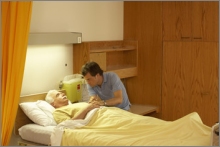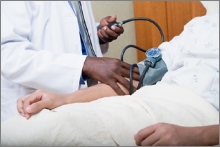Coming Back From the Dead: Shocking Number of People in a "Vegetative State" are Misdiagnosed
by www.SixWise.com
More than 40% of people diagnosed as being in a persistent vegetative state (PVS) are misdiagnosed. They are actually minimally conscious. They have gradually come out of a coma into a state of minimal awareness.
|
Definitions:
-
Comatose: A brain-impaired person who cannot be awakened, is unable to respond normally to light or pain, does not have sleep-wake cycles, and who does not take voluntary actions. The comatose person is in a profound state of unconsciousness
-
Persistent Vegetative State (PVS): A state of wakefulness without any detectable awareness. This occurs in patients with severe brain damage, where the coma has progressed to a state of PVS.
-
Locked-in State: The patient is aware and awake with no loss of cognitive function, but due to damage to the motor cortex, he or she cannot move or communicate because nearly all voluntary muscles in the body are paralyzed. Quadriplegics are in a locked-in state but can learn to communicate through coding messages or eye movement.
-
Brain Death: This occurs when there is no brain activity and no possibility of regaining any brain activity. The individual can no longer make his or her organs function in order to stay alive -- machines keep the heart and lungs working.
|
Research Shows That PVS is Misdiagnosed More Than 40% of the Time
|

Many people who are diagnosed as being in a persistent vegetative state are actually capable of being rehabilitated.
|
One particular study conducted at the Royal Hospital for Neurodisability in London, England found that 17 out of 40 patients previously diagnosed as being in PVS were misdiagnosed. Forty-three percent of the patients were in fact aware, but their awareness went undetected. Researchers determined that a "diagnosis cannot be made, even by the most experienced clinician, from a bedside assessment." Researchers claimed that the vegetative state requires considerable skill to diagnose.
Visual tracking and auditory detection are two of the tests used to determine if a patient is in PVS. However, many misdiagnosed patients either have a severe visual handicap or they are blind and/or deaf. Visual tracking and auditory detection are therefore not reliable methods for determining the state of a patient's awareness, unfortunately they are commonly used methods in determining states of awareness.
The London researchers concluded that assessment should be done over a period of time by a multidisciplinary team who has experience managing complex disabilities.
New Scanner Makes it Possible to Accurately Diagnose States of Awareness
The Impaired Consciousness Study Group, a Cambridge-based brain-research team, is exactly that -- a group of specialists with various areas of expertise that assist them in studying and helping those with impaired consciousness.
Founder Dr. Adrian Owen, Cambridge neuroscientist, developed a novel scanning device that detects fluctuating levels of brain activity when patients are presented with familiar stimuli. As is often the case, when a patient in a minimally aware state is shown photographs of loved ones, there are significant fluctuations in brain activity, as opposed to being shown meaningless or blank pictures.
For those patients with visual impairment, Owen has asked them to imagine playing tennis, or walking, for instance. What Owen's scanner shows is that the part of the brain responsible for motor skills bursts into action. This scanner has created a way to communicate with patients who may be physically unable to communicate.
Rehabilitation is Possible
If it weren't for Dr. Owen's scanner, Kate Bainbridge, a teacher who was misdiagnosed as being in PVS, would probably never have been given the rehabilitation and treatment that has allowed her to make a remarkable recovery, although she still has some physical challenges. The scanner showed that it might be possible for her brain to heal itself slowly with regular "exercises," such as being slowly and systematically presented with stimuli to foster that healing process.
|

Experts are calling for new criteria to accurately diagnose PVS, as bedside observation alone is not enough.
|
According to Kate, "Other scans show doctors what is wrong with your brain, but Dr Owen's show what is working. It gave them a reason to carry on with my recovery. It really scares me to think where I would be if I hadn't had it."
Rehabilitation psychologist Lesley Murphy states, "Awareness is not unlike muscular fitness: it requires exercise, and a stamina of "consciousness" can be developed, provided there is something to build on."
New Criteria is Necessary to Make Accurate Diagnoses and Informed Decisions About Ending an Impaired Patient's Life
Consider the possibilities if the 40% of those misdiagnosed as PVS were instead accurately diagnosed as being minimally conscious or in a locked-in state. They could receive the rehabilitation or treatment necessary to potentially recover or live a functioning life.
It is crucial to understand that patients cannot be diagnosed with PVS by bedside observation alone. Misdiagnosed patients are denied the opportunity to be given valuable rehabilitation. They are placed in the wrong hospital wards or in care homes where their needs go unmet and misunderstood. Dr. Owen and his research team are making huge advancements toward helping clinicians make correct diagnoses and increasing the quality of life of minimally aware patients.
Approximately 20% of PVS-diagnosed patients return to fully functioning normality. This could be because a large number of those who recovered were actually misdiagnosed in the first place. A correct initial diagnosis could help many more with impaired consciousness to be rehabilitated or live with an improved quality of life.
The other side of the coin is that many of those individuals thought to be in PVS wind up dying by the request of their family members or their own living will. Removing an impaired patient's feeding tube to bring on death is often considered humane. Sometimes it is the case that a person is brain dead and thus there is no hope of recovery. Sometimes the spouse of the patient has a new partner and a new life and wants to move on. Sometimes loved ones can't stand the thought of their family member being trapped inside their body.
And sometimes there is a misdiagnosis and there is awareness when there was thought to be none ... there is hope when there was thought to be none.
This high rate of misdiagnosis should challenge actions to bring on the death of such patients. There's a faulty system in place when it comes to diagnosing and caring for impaired patients. Given the advanced technology and knowledge we now have, thanks to people like Dr. Owen and his team, new criteria should be made when it comes to determining one's diagnosis, as well as when it comes to ending someone's life.
Recommended Reading
The Top 5 Causes of Head Injuries and How to Avoid Them
The 7 Most Dangerous Youth Sports in America
Sources
Andrews, Keith, et al. Misdiagnosis of the Vegetative State: Retrospective Study in a Rehabilitation Unit. BMJ. July 6, 1996. 313: 13-16.
Timesonline.co.uk. The Undead. December 9, 2007.